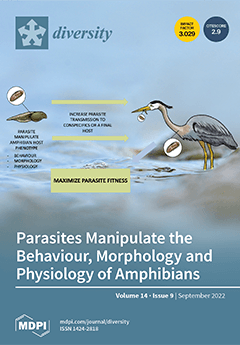Traditional classification based on morphological characters suggests that the genus
Ostericum is closely related to
Angelica, but molecular phylogenetic studies suggest that the genus
Ostericum is related to
Pternopetalum rather than
Angelica. In this study, the plastomes of nine
Ostericum species
[...] Read more.
Traditional classification based on morphological characters suggests that the genus
Ostericum is closely related to
Angelica, but molecular phylogenetic studies suggest that the genus
Ostericum is related to
Pternopetalum rather than
Angelica. In this study, the plastomes of nine
Ostericum species and five
Angelica species were used to conduct bioinformatic and comparative analyses. The plastomes of
Ostericum and
Angelica exhibited significant differences in genome size, gene numbers, IR junctions, nucleotide diversity, divergent regions, and the repeat units of SSR types. In contrast,
Ostericum is more similar to
Pternopetalum rather than
Angelica in comparative genomics analyses. In total, 80 protein-coding genes from 97 complete plastomes and 112 ITS sequences were used to reconstruct phylogenetic trees. Phylogenies showed that
Angelica was mainly located in Selineae tribe while
Ostericum was a sister to
Pternopetalum and occurred in the
Acronema clade. However, morphological analysis was inconsistent with molecular phylogenetic analysis:
Angelica and
Ostericum have similar fruit morphological characteristics while the fruits of
Ostericum are quite different from the genus
Pternopetalum. The phylogenetic relationship between
Angelica and
Ostericum is consistent with the results of plastome comparisons but discordant with morphological characters. The cause of this phenomenon may be convergent morphology and incomplete lineage sorting (ILS).
Full article





